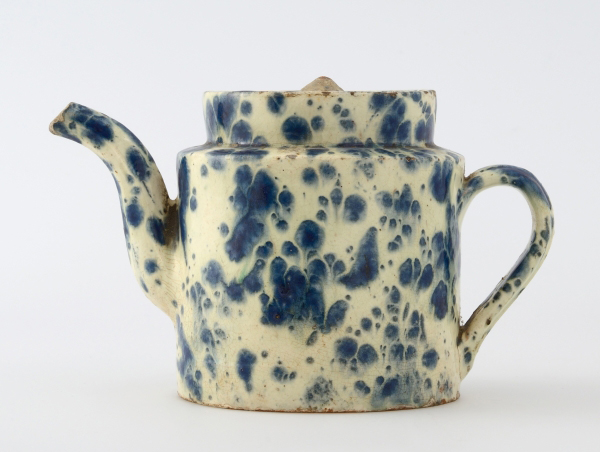
Splashed decoration is one of the easiest and quickest decorative techniques used in pottery making. It is almost impossible to definitively distinguish between decorations achieved by splashing and those achieved by dripping. There is also a large grey area between splashed decoration and crawling or streaky glaze, where it is not immediately obvious whether the effect was intentional or whether it was due to the glaze melting. There are two distinctly different ways of producing splashed decoration. One is to splash coloured slip onto the leather-hard or biscuit-fired vessel, which may already exhibit a coat of slip, and then apply a glaze which can be either coloured or colourless. The other is to splash coloured or colourless glaze onto the vessel, which has already been glazed but is still very wet, resulting in more blended and runny patterns.
Splashed decoration was very often applied to unslipped vessels or vessels with a coat of white or red slip as well as to light-coloured earthenware. Yellow or green glaze added yet another optional variation. The splashing involved dipping a rough brush, a goose quill, a bundle of straw or a little besom into slip or glaze of a colour that differed from the vessel itself or its glaze and then splashing it onto a row of vessels that had already been slipped or glazed. Sometimes, different colours were used one after the other (e.g. white and black-brown or green and black-brown). If the slip or glaze on the vessel was very wet, marbling and other runny patterns could be achieved by shaking the vessel with quick, sharp motions (wet-on-wet technique).

Splashing colourless glaze onto a vessel that had already been coated in white slip and then in green or manganese purple/dark brown glaze resulted in vessels with light splashes or speckles.
Translation Sandy Hämmerle
German: Spritzdekor
French: décor tacheté, décor moucheté, décor pommelé, céramique engobée à taches brunes ou vertes
References:
Blondel 2001
Nicole Blondel, Céramique, vocabulaire technique, Paris 2014, 308, 344.
Heege 2016
Andreas Heege, Die Ausgrabungen auf dem Kirchhügel von Bendern, Gemeinde Gamprin, Fürstentum Liechtenstein. Bd. 2: Geschirrkeramik 12. bis 20. Jahrhundert, Vaduz 2016, bes. 88-89.

